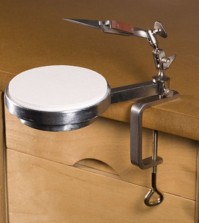- NEW DVD Series – Stone Setting with Bezels
- Tube Set Charm by Kim St. Jean
- Prong Basket Pendant by Kim St. Jean
- NEW DVD Series – Stone Setting with Cold Connections
- New DVD Series – Stone Setting with Wire
- NEW DVD Series: Introduction to Stone Setting by Kim St. Jean
- Featured Tool: Bracelet Bending Plier
- NEW Dvd by Eva Sherman
- Fun, Fast Fold Forming DVD Series
- Double Band Ear Cuff from Alex Simkin
Conquering Your Fear by Lexi Erickson
Conquering Your Fear by Lexi Erickson
Lexi Erickson is the President of Wubbers University and a Contributing Editor to Lapidary Journal Jewelry Artist. After spending years as an archaeologist, she picked up a Masters Degree in Jewelry Design and Fabrication and added teaching university level jewelry classes to her teaching repertoire.
Lexi has 6 best selling DVDS on jewelry techniques, along with the definitive guide to soldering, How To Solder Jewelry and Everyones’s Guide to How to Solder Jewelry, published by Interweave. Her teaching style is witty, relaxed and laid back, and she instills confidence in every student. You will definitely conquer your fear of soldering and come out a winner with her techniques
(audio not playing? click here)
Explore Lexi’s Class this February in Tucson:
Beginning Textured and Soldered Bangles
Feb.5, 2:30 – 6:00pm
Transcript of our interview with Lexi Erickson
Heather: We are on the phone with Lexi Erickson, Lexi how are you doing?
Lexi: I am just fine. It’s cold here; we had a cold front come through.
Heather: Oh boy…Lexi is going to be teaching with us at the JOGS show this year, she has agreed to take a few minutes for an interview today. Let’s start with medium do you primarily work in? And basically how you arrived at that?
Lexi: I started out with university classes, so I started out in silver. It was $4.00 an ounce then. One could experiment in silver with pure abandon. If it didn’t work out, well, use it in casting. My first teacher said you couldn’t solder copper and silver, so I didn’t do much with that then. By my second semester I started experimenting with copper and silver, and saw you could solder it, much to my teacher’s surprise. Sure there was a learning curve, but I kept on until I got it right. Later on I leaned some bail beading techniques, and played with polymer clay, but I was hooked on metal. I tried PMC, it just wasn’t my medium. I could do something in metal in less time than it took in PMC! So I’ve pretty much stayed with metals, with silver, copper, brass, and when I can afford it, gold.
Heather: What are the tools you use most often?
Lexi: I am a person who loves hand tools, I love hand finishing. I probably own 50 files, all shapes and sizes, and pliers, my Wubbers of course, and hammers. Oh, and various sandpapers, too.
Heather: Have you ever improvised a tool, or repurposed a tool?
Lexi: Hmmmmm. Well, I when I started, there was not a large variety of tools. I improvised a few sets of pliers, cut grooves in them, sanded the edges, covered the jaws with copper to keep them from marring jewelry, basic stuff like that. My biggest “invention” has been the soldering station and turntable, which is coming out soon. JewelryTools.com will be carrying it, too. I’m pretty excited about that. It keeps the soldering area clean and helps with soldering by being able to see all around the piece as you move the turntable. I’m pretty excited about it. They’ve sold so well I haven’t been able to keep up with the sales and shipping on it.
Heather: That is exciting! What is your favorite way to finish a piece, or your favorite effect?
Lexi: Hand finishing. I love sandpapers that give that elegant sanded finish. All grits of sandpaper are fabulous, and give a different finish. Sandpapers are great. Never throw away a piece of sandpaper, it can always be used.
Heather: What advice would you give to a beginner who’s maybe a bit intimidated by how intricate the process seems?
Lexi: It’s only metal. You’ll never lose metal, it can always be melted down for casting or melted into small accent balls. Don’t stress over mistakes. Nobody died! Breathe! The mark of a true artist is where you can take a mistake and make something of it. I have a sign in my studio that says “we don’t make mistakes, we make variations.”
Heather: That’s some great advice!
Lexi: Truly though with a student half the technique or success is learning the technique the other half is how to fix your mistakes.
Heather: A lot of people wonder, when you make a piece you are happy with where does it go?
Lexi: I keep it. My first teacher told us never to get rid of our first semester pieces, so I still have those, and a few I’ve made over the years. If I really love a piece, and it has special stones or beads, I don’t have to sell it. I’m lucky that way. I have done the galleries and lots of shows, all kinds of marketing, but for the last 2 years I have basically chosen not to sell anything I make. To me, to make a piece only for an economic reward at the end ruins both the spirituality of the piece and the joy I have in creating it.
Heather: What gives you inspiration to try new things? What keeps you motivated?
Lexi: I live in a very inspirational part of the country. I live in the Rocky Mountains. I’m inspired by the geology and geomorphology of the American Southwest, the patinas of her canyons and the archaeology of the Ancients. My design exercises are hikes into her back country, looking for and recording textures, colors, and the Spirit of Place which emerges in metal as a piece of my soul. My pieces are very spiritual to me.
Heather: That’s beautiful. So you’ve been making and teaching jewelry for several years, what have you noticed about your work that’s evolved?
Lexi: Oh you’re too kind… “several years” (laughter.) How my work has definitely changed!!! Remember I came from an Archaeology background, not really an art one. I didn’t start out wanting to make jewelry, just to understand what bronze was for an archaeology class. I never wanted to be a jewelry designer. So, I started out with a preconceived idea what jewelry was. I didn’t know what jewelry design was, or art jewelry, and I had a very limited design background. My mom had some nice jewelry store jewelry. Growing up in the Southwest, I was influenced by Navajo and Hopi jewelry, mostly turquoise and silver. So I did a lot in that style. At one time I was the Queen of High Polish. My teacher had said that was the hardest finish to do, so I experimented until I got it perfected. Every piece was technically perfect, and not a scratch or mistake on it. I put my pieces out there with all my classmates, and theirs had textures, scratches, imperfections. Mine was so shiny that I handled them with cotton gloves. And they had no soul. My classmates were full of texture, they looked handmade and organic. Mine were hard, shiny and boring. I got straight A’s, but I hated every piece. I started adding texture, patinas, and started liking my work more. Now I’m in love with patinas and textures, and really known for that and my hand finishing.
Heather: Wonderful. What’s something you’ve learned from one of your students?
Lexi: Only one thing?
Heather: What’s the first thing that pops into your mind?
Lexi: I learn from all of my students but Mark Wengryn, he’s a fabulous up and coming jeweler on the east coast and he took his first jewelry classes with me. One day he had some pieces that were unlevel so he said what can I use to level this, and thinking how long I had been in this (and this had only been a few years when this had happened) I said just put a penny underneath it and solder it and level it. A few minutes later he came back and said “uhh Lexi I have a problem” and he handed me this penny that had totally melted into his piece. I was so embarrassed because they don’t make copper pennies any more. He had this piece he just about finished with it then had this blob. I learned don’t use coins anymore to level your pieces.
Heather: Why do you think people love to wear jewelry and why do you think people love to make jewelry?
Lexi: Wow, two really deep questions. Jewelry has a lot of meaning to people. My work looks like it was dug up yesterday, and it’s old and from some archaeological dig. It’s who I am. It’s very personal and deeply spiritual to me. Most of the pieces I design are conversation starters and have a lot of symbology. I really don’t want anyone to buy my necklace just to go with their blue sweater. Throughout history people have worn jewelry to show marriage status, social status, power, goals they have met, prestige, employment and fraternal status in organizations. It’s a tiny piece of personal sculpture who expresses who you are. If you think about it, you wear rings and bracelets for yourself; you wear earrings, brooches, and necklaces for other people. It expresses who you are.
Heather: Very meaningful.
Lexi: The other part of the questions, why you think people love to make jewelry. Making art jewelry is really a recent phenomena here in the US. Think about it. Thirty years ago there were not many books, or many tools for jewelry making. You apprenticed from a master. It wasn’t taught in many colleges or universities. Making jewelry is different now and it’s different from other art forms. It’s been considered a craft in the US (and please don’t confuse that with craftsmanship) while in Europe it’s always been considered art. In years back, a piece was priced according to the amount of precious metals and precious stones, or the weight of the gold. No attempt to pay for design was considered. Yet no one ever asked a painter how much the paint and canvas costs, or asked a sculptor how much the stone costs. So making jewelry has had its limitations in the past. But now there is a full acceptance of all kinds of jewelry as art jewelry, and personally I prefer the term “studio jewelry.” There has been a freedom which has evolved, probably from the New York/East Coast jewelers of the 1930’s through 50’s. Alexander Calder, Art Smith, Sam Kramer, and Margaret De Patta have freed up our thinking about what jewelry is. It’s so refreshing that we have had this surge in our art form, and a tremendous opening of our minds. And with that comes the desire to create and experiment, which always leads to new invention.
Heather: Great Lexi! Thank you so much for taking time out of your day to delve a little bit deeper into the art of jewelry with us.
Lexi: You are certainly welcome!
Heather: Lexi is going to be teaching with us at the JOGS show this year and I HIGHLY recommend everyone come take a class with her.
Lexi: I look forward to seeing everyone in Tucson!
Don’t Miss Lexi in Tucson!
Beginning Textured and Soldered Bangles
Feb.5, 2:30 – 6:00pm
Take a look at all of our other classes on JewelryTools.com
























0 comments